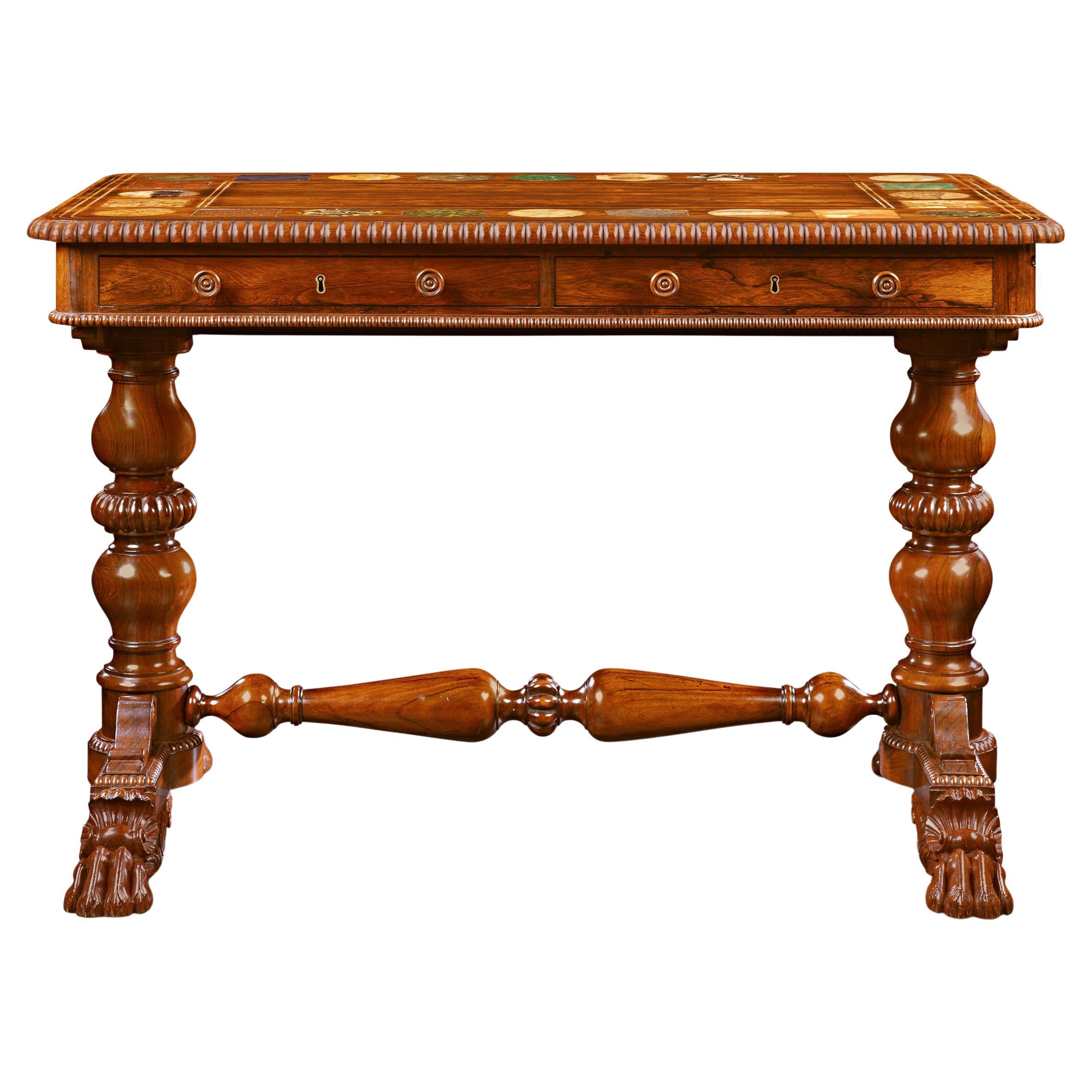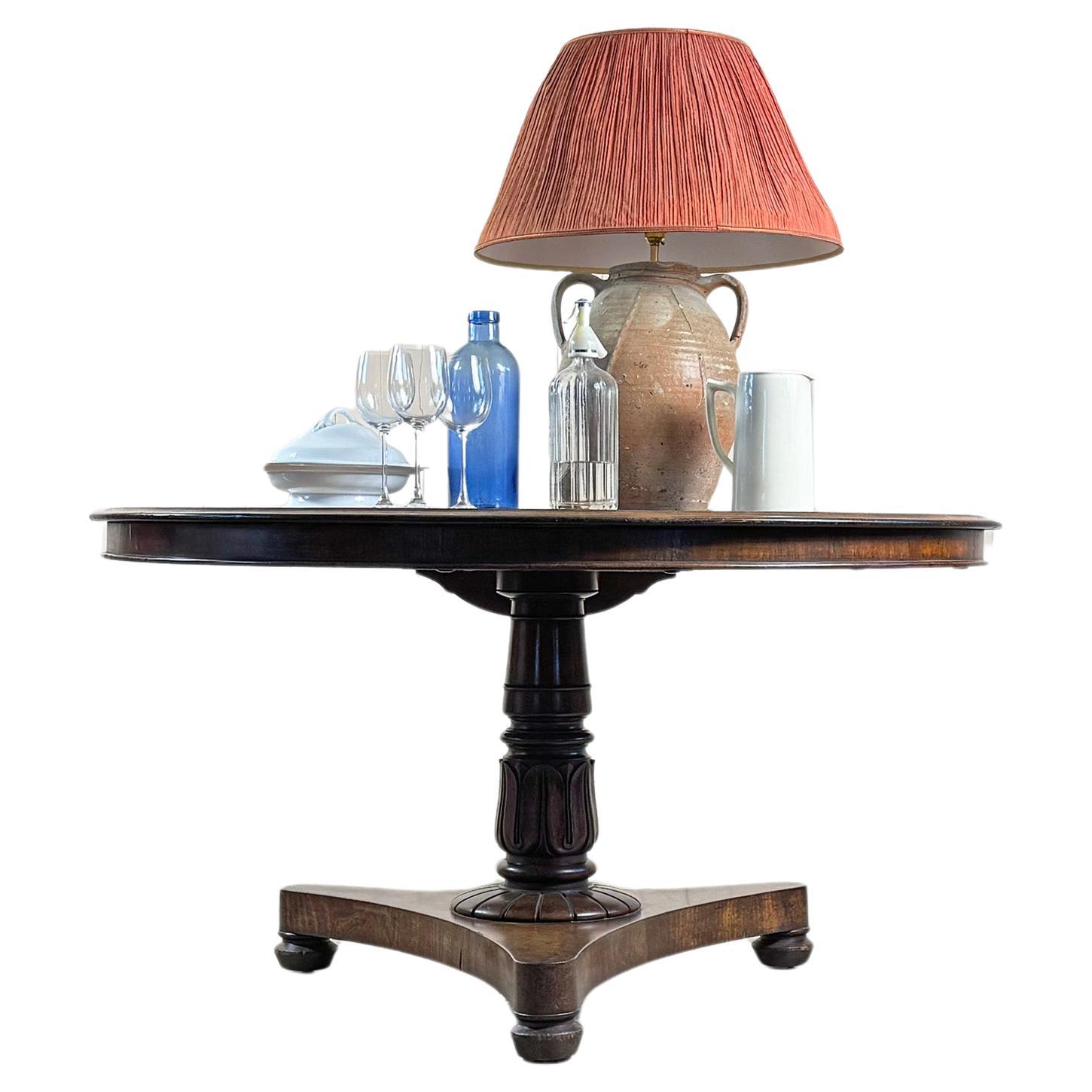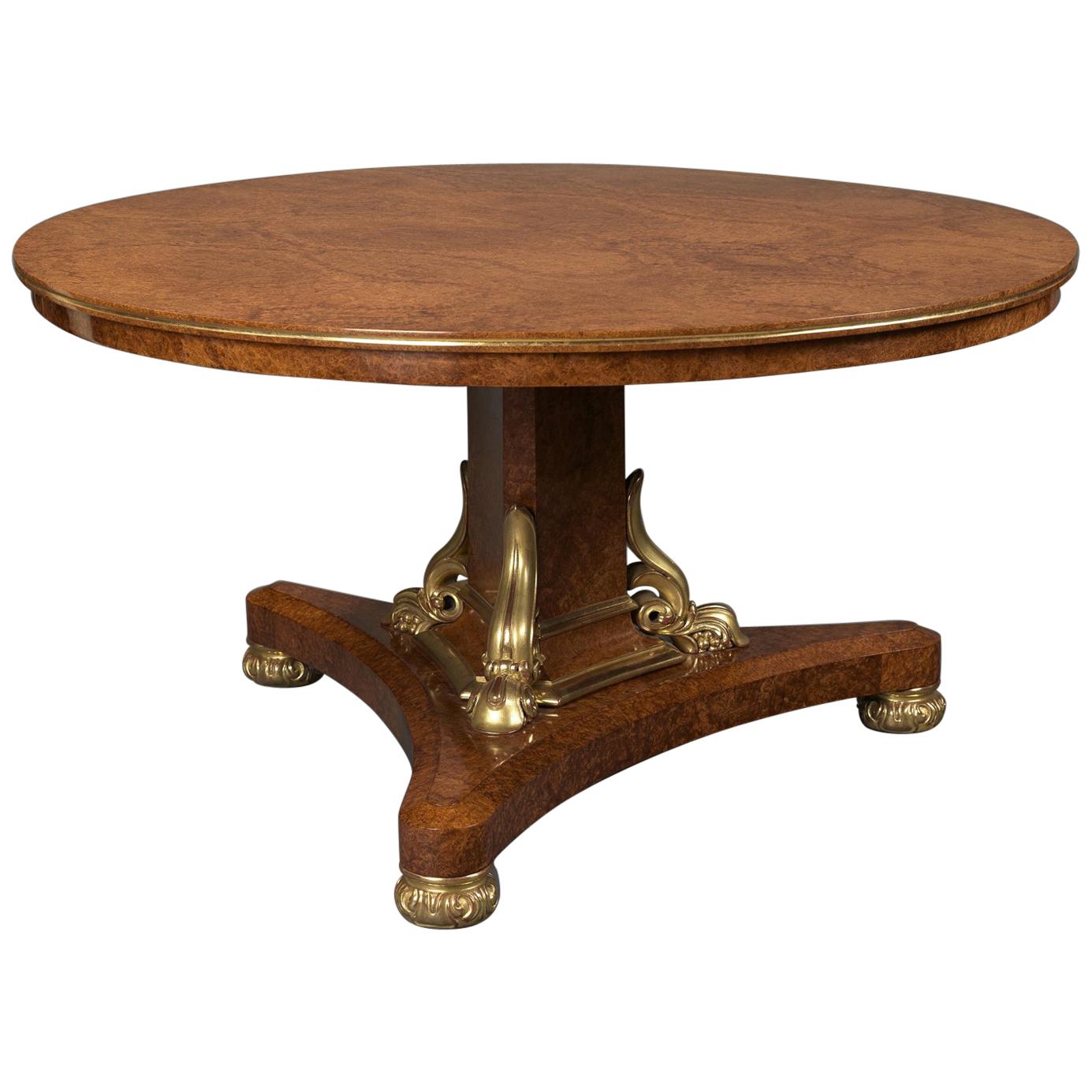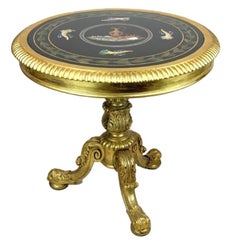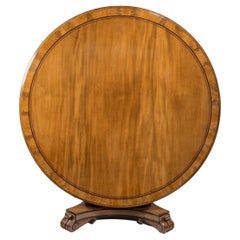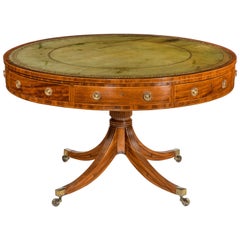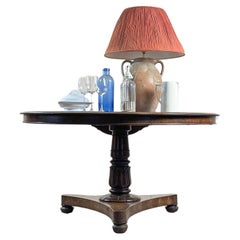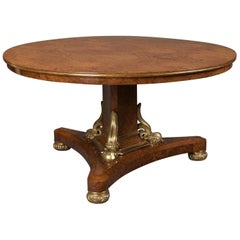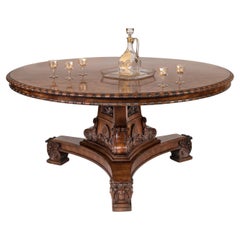Items Similar to A large George IV brass inlaid rosewood centre table attributed to Gillows
Want more images or videos?
Request additional images or videos from the seller
1 of 13
A large George IV brass inlaid rosewood centre table attributed to Gillows
About the Item
The circular tilt top has a central field of book-matched, figured rosewood within a broad band of cut brass inlay. The edge is boldly carved with an acanthus and dart border. The central support is hexagonal in section with a broad central flange, raised on three powerful and ornately carved legs. The knees are presented as bold acanthus carved and gadrooned volutes. The lions’ paw feet have clearly defined knuckles and claws and enclose the original brass castors. English, circa 1825.
See also S. Stuart, Gillows of Lancaster and London 1730-1840, Antique Collectors’ Club, Woodbridge, 2008, Vol II, pl. E.5, which shows a pattern for this table in a drawing room layout designed for G.Bamford about 1820-30. The drawing also shows a pair of bergères and a sofa which correspond to a suite supplied by Gillow & Co. in 1824 to Thomas Wynn (d.1832), 2nd Baron Newborough, for Glynllifon, Caernarvonshire, Wales. Parallels to the cut-brass work and anthemion carved edging on a long table are shown ibid., Vol. I, p.291, pls 308 and 309.
- Attributed to:Gillows of Lancaster & London (Maker)
- Dimensions:Height: 30 in (76.2 cm)Diameter: 57.5 in (146.05 cm)
- Style:George IV (Of the Period)
- Materials and Techniques:
- Place of Origin:
- Period:
- Date of Manufacture:Circa 1825
- Condition:Wear consistent with age and use.
- Seller Location:Lymington, GB
- Reference Number:1stDibs: LU973036259582
About the Seller
5.0
Recognized Seller
These prestigious sellers are industry leaders and represent the highest echelon for item quality and design.
Established in 1982
1stDibs seller since 2013
127 sales on 1stDibs
Typical response time: 8 hours
Associations
LAPADA - The Association of Arts & Antiques Dealers
- ShippingRetrieving quote...Shipping from: Lymington, United Kingdom
- Return Policy
Authenticity Guarantee
In the unlikely event there’s an issue with an item’s authenticity, contact us within 1 year for a full refund. DetailsMoney-Back Guarantee
If your item is not as described, is damaged in transit, or does not arrive, contact us within 7 days for a full refund. Details24-Hour Cancellation
You have a 24-hour grace period in which to reconsider your purchase, with no questions asked.Vetted Professional Sellers
Our world-class sellers must adhere to strict standards for service and quality, maintaining the integrity of our listings.Price-Match Guarantee
If you find that a seller listed the same item for a lower price elsewhere, we’ll match it.Trusted Global Delivery
Our best-in-class carrier network provides specialized shipping options worldwide, including custom delivery.More From This Seller
View AllLate Regency Giltwood Centre Table Attributed to Gillows
By Gillows of Lancaster & London
Located in Lymington, Hampshire
A very attractive antique late Regency giltwood centre table attributed to Gillow of Lancaster and London, inset with an Italian Pietra Dura top,
The central turned baluster supp...
Category
Antique Early 19th Century English Regency Center Tables
Materials
Giltwood
George IV Ebony-Inlaid Mahogany Tilt-Top Centre Table
Located in Lymington, Hampshire
A George IV ebony-inlaid mahogany tilt-top centre table, the circular top with a flame-veneered cross-banded border above a moulded frieze with ebony stringing and four small rectang...
Category
Antique 1820s English George IV Center Tables
Materials
Ebony, Mahogany
Late George III Revolving Mahogany Drum Table Attributed to Gillows
By Gillows of Lancaster & London
Located in Lymington, Hampshire
A late George III revolving mahogany drum table attributed to Gillows, the circular top inset with a faded and gilt tooled green leather above four full and four dummy frieze drawers...
Category
Antique Early 1800s English Tables
Materials
Mahogany
A fine George IV mahogany wine cooler attributed to Gillows
By Gillows of Lancaster & London
Located in Lymington, Hampshire
A fine George IV mahogany wine cooler attributed to Gillows, in the form of a classical urn with everted lip and boldly gadrooned sides, set upon a flaring, flanged support with flut...
Category
Antique 1810s English George IV Wine Coolers
Materials
Mahogany
An unusual George IV specimen marble backgammon table attributed to Gillows
By Gillows of Lancaster & London
Located in Lymington, Hampshire
An unusual George IV specimen marble backgammon table attributed to Gillows. This rectangular table is strongly attributed to Gillows. It has a rectangular top inlaid with a central chess board flanked by two backgammon fields, all inlaid with a multitude of specimen marbles. One edge carved and gilded with the Latin motto ‘Turpe est in patria vivere et patriam ignorare’. The oak base has a drawer for cards and playing pieces, all raised on a square section support with four splayed legs and the original brass castors. English, circa 1830.
Provenance: Geoffrey Bennison Ltd, London, November 1983
The Mermaid House Collection, St. John’s Wood, London
Property of a gentleman
Private American collection
The form of the base of this table is related to several known Gillows commissions from the late Regency period and the quality of the cabinet work also suggests that firm attribution to the firm. Backgammon tables, rather than more general games tables, are unusual at this date and the use of inlaid specimen marbles in the top suggests a client of wealth. Additionally, the Latin text on the edge of the table provides further clues. The text, Turpe est in patria vivere et patriam ignorare, translates as “it is shameful to live in your homeland and not know it”. This phrase dates back to antiquity but rose to prominence once again in the mid-18th century when used by the botanist and key Enlightenment figure Carl Linnaeus in his work on the native flora of Sweden. The combination of this phrase and the use of native English timbers and marbles is promoting English raw materials and craftsmanship at a time when the noble and the wealthy were focussed on European pietra dura tables.
Mermaid House in St John’s Wood was re-designed by Chester Jones...
Category
Antique 1830s English George IV Game Tables
Materials
Marble
A George IV rosewood and scagliola occasional table attributed to Gillows c.1825
By Gillows of Lancaster & London
Located in Lymington, Hampshire
The rectangular top of this table tilts up to display a scagliola landscape scene showing the ruins of the Roman Forum, the Temples of Vespasian and Saturn, the Column of Phocas and ...
Category
Antique 1820s English William IV Side Tables
Materials
Scagliola, Rosewood
You May Also Like
Hardstone and Rosewood Centre Table Attributed to Gillows
By Gillows of Lancaster & London
Located in New Orleans, LA
This remarkable rosewood centre table attributed to legendary firm Gillows showcases masterful craftsmanship and stunningly rare hardstone specimens. The table's base is ornately crafted, complete with lion's paw feet, emphasizing the quality of the wood. The most impressive element of this beautiful piece of furniture, however, is the exquisite inlaid table top. Featuring eighteen semi-precious and hardstone specimens artfully arranged in alternating geometric shapes, rare stones like gem quality Lapis Lazuli, Egyptian porphyry and Siberian amethyst dazzle the eye. Other stones and specimens inlaid in square, circle and hexagon shapes include pyrite lapis lazuli, malachite, green aventurine, agate of amethyst, greek spartan porphyry, labradorite, fossilized wood, occhio di pavone, brèche verte d'égypte, sicilian jaspers, blood stone, spanish brocatelle, siena brocatelle, convent siena and nero antico. The sheer variety and superb quality of these features is an overwhelming visual delight and a triumph of craftsmanship.
Hardstone pieces such as this were popular among the British aristocracy...
Category
Antique 19th Century Regency Center Tables
Materials
Agate, Amethyst, Lapis Lazuli, Malachite, Porphyry
George IV Rosewood Centre Table
Located in Cirencester, GB
We sourced this c.1820's table from the Old House, Aspley Guise, Bedfordshire.
The circular top with coromandel crossbanding, above a turned column with foliate detail and a tripod ...
Category
Antique 1820s British George IV Center Tables
Materials
Rosewood
George IV Centre Table Attributed to Thomas & George Seddon, circa 1830
By Thomas & George Seddon
Located in Brighton, West Sussex
A Very Fine George IV Parcel-Gilt Amboyna Centre Table Attributed to Thomas & George Seddon.
English, Circa 1830.
The table is of finely figured Amboyna with a circular tilt-top above a triform column with parcel-gilt scrolled supports. It is raised on a conforming plinth base with foliate carved feet and concealed castors.
George Seddon was the eighth child of John Seddon of Blakelea, Lancashire. His father apprenticed him to George Clemaphon of Cripplegate to learn cabinet making. He became a master cabinet maker. (He was Master of the Joiner’s Company in 1795).
In the early 1750s he was sufficiently successful to acquire London House, Aldersgate Street. It consisted of extensive workshops, where furniture was made, and showrooms to display the finished products. London House had formerly been a palace of the Bishops of London. The panelled state-rooms were ideal for the display of fashionable furniture; and the chapel and library made convenient workshops. When Seddon married, he converted the garden house and infirmary into the family home. Seddon was the biggest furniture maker of his time. His furniture store covered a two acre site in Aldersgate Street.
His workshop there was described by London visitor Sophie v. La Roche in 1786:
"We drove first to Mr. Seddon's, a cabinet-maker,...He employs four hundred apprentices on any work connected with the making of household furniture—joiners, carvers, gilders...
Category
Antique Early 19th Century English George IV Center Tables
Materials
Wood
19th Century William IV Period Mahogany Centre Table Attributed to Gillows
By Gillows of Lancaster & London
Located in London, GB
A William IV Period Mahogany Centre Table
Attributed to Gillows
Constructed from a flamed Honduras Mahogany, book-matched with great effect on the top; the table supported on an inc...
Category
Antique 19th Century English William IV Center Tables
Materials
Mahogany
George IV Period Games Table Attributed to Gillows of Lancaster
By Gillows of Lancaster & London
Located in London, GB
Constructed in a finely figured goncalo alves; the end supports having square uprights, each enclosing three tapering and turned ‘triple spindles’, with ‘running pearl’ adornments, a...
Category
Antique 19th Century English George IV Game Tables
Materials
Wood
Rare George IV Period Amboyna Inlaid and Carved Giltwood Centre Table
By Morel & Seddon
Located in London, GB
A magnificent library centre table of exhibition quality of the
George IVth period, in the Manner of Morel & Seddon.
Constructed in amboyna, with holly and specimen woods used in t...
Category
Antique 19th Century English George IV Center Tables
Materials
Giltwood, Amboyna
